Introduction
Introducing Black Apple for Excel by Mark Kubiszyn
Black Apple Dark Pivot Table & Table Theme Template for Excel 2016 (32bit or 64bit, Version 16.0) Office 365 runnng Windows 11
Black Apple is a Dark Theme for Excel that includes Styling for Tables, Pivot Tables and Slicers. It uses a variety of subtle dark green accents and graduated fades together with two Blue Chart Colours. It uses a deep red for highlighting variances. Black Apple comes as a .XLSX Template and a .XLSM Macro-enabled Template that uses a modified T.O.C. (Table of Contents) Sheet built using my Treelist Software. Black Apple was designed from scratch using an Arial Font at 10pt and looks great on a Laptop at 80% Zoom
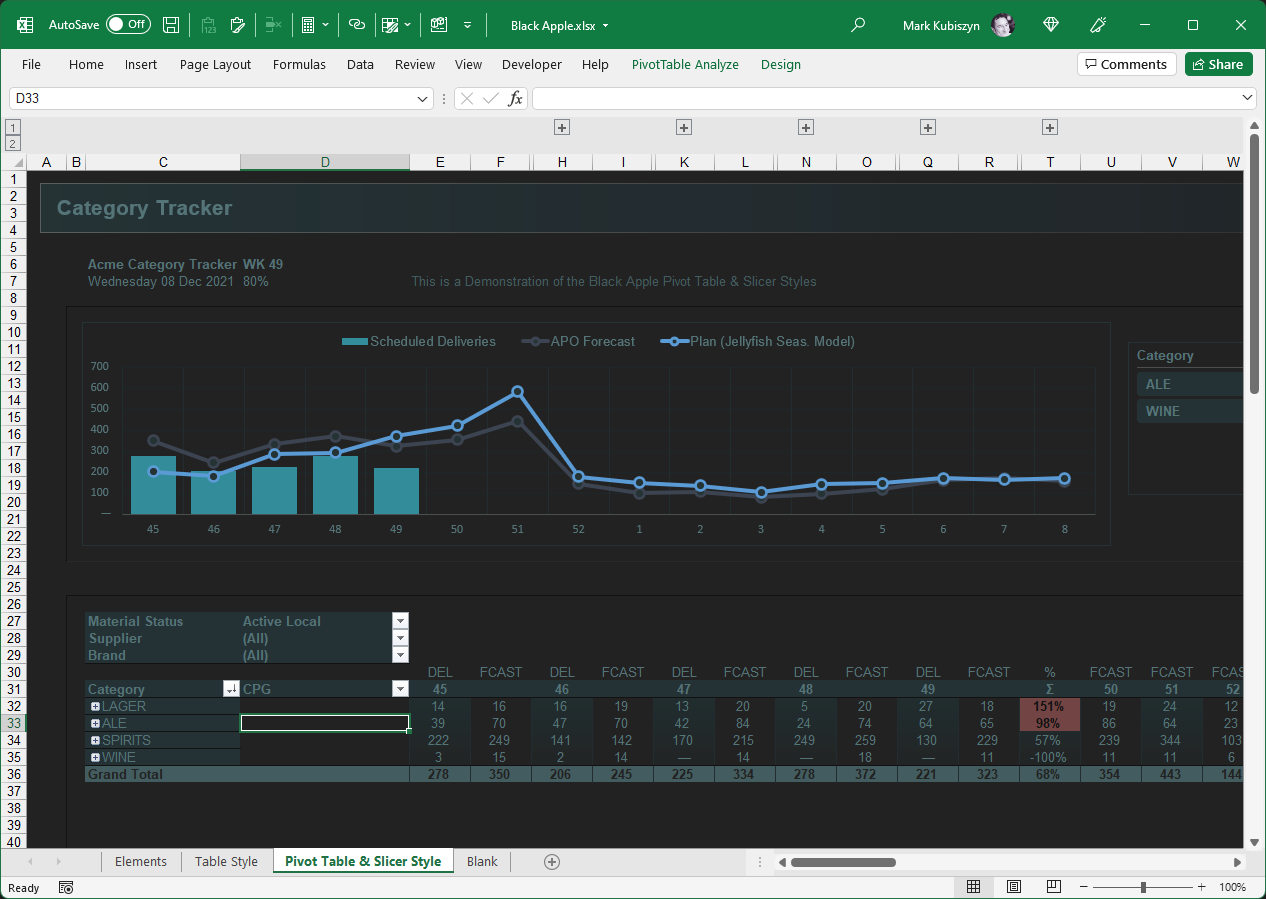
If you like this Project, you may also like:
Dark Excel
Rhino (FREE direct download 10KB)
Rhino (FREE direct download Zip File with all of the Examples 204KB)
Treelist
Prerequisites
- Microsoft Excel 2016 Version 16 (32bit or 64bit) · this Software is designed for Office 365 running Windows 10 or WIndows 11
- Basic to moderate Excel Skills and some VBA skills to import Code Modules into own Project if not using the purchased Spreadsheet
- Windows PC · NOT a Mac!
- No support is provided for customization of this Software
Features
- Features a single Normal Cell Style so that whenever a new Sheet is inserted into the Workbook it automatically picks up the Black Apple dark theme for Cell Fill and Font Colour
- Pivot Table & Slicer Styles to give your Pivot Tables & Slicers a dark theme with subtle dark green accents and graduated fades
- A dark themed Chart using my Scooter, Picton Blue and Rhino Colours
- An Elements Sheet detailing how to design the 3D Borders used by Dark Apple, Two Buttons, Grids, Custom Cell Formatting and the main Colours used by the Templates
- A Table Style in a similar dark theme as the Pivot Table
- A Blank Sheet with a single Black Apple Header Image
- Code detailing how to protect the Header Object, Chart and Slicers and prevent direct user interference which even works for a finished .XLSX file
- The .XLSM is Macro-enabled as it uses a modified T.O.C. (Table of Contents) Sheet built using my Treelist Software
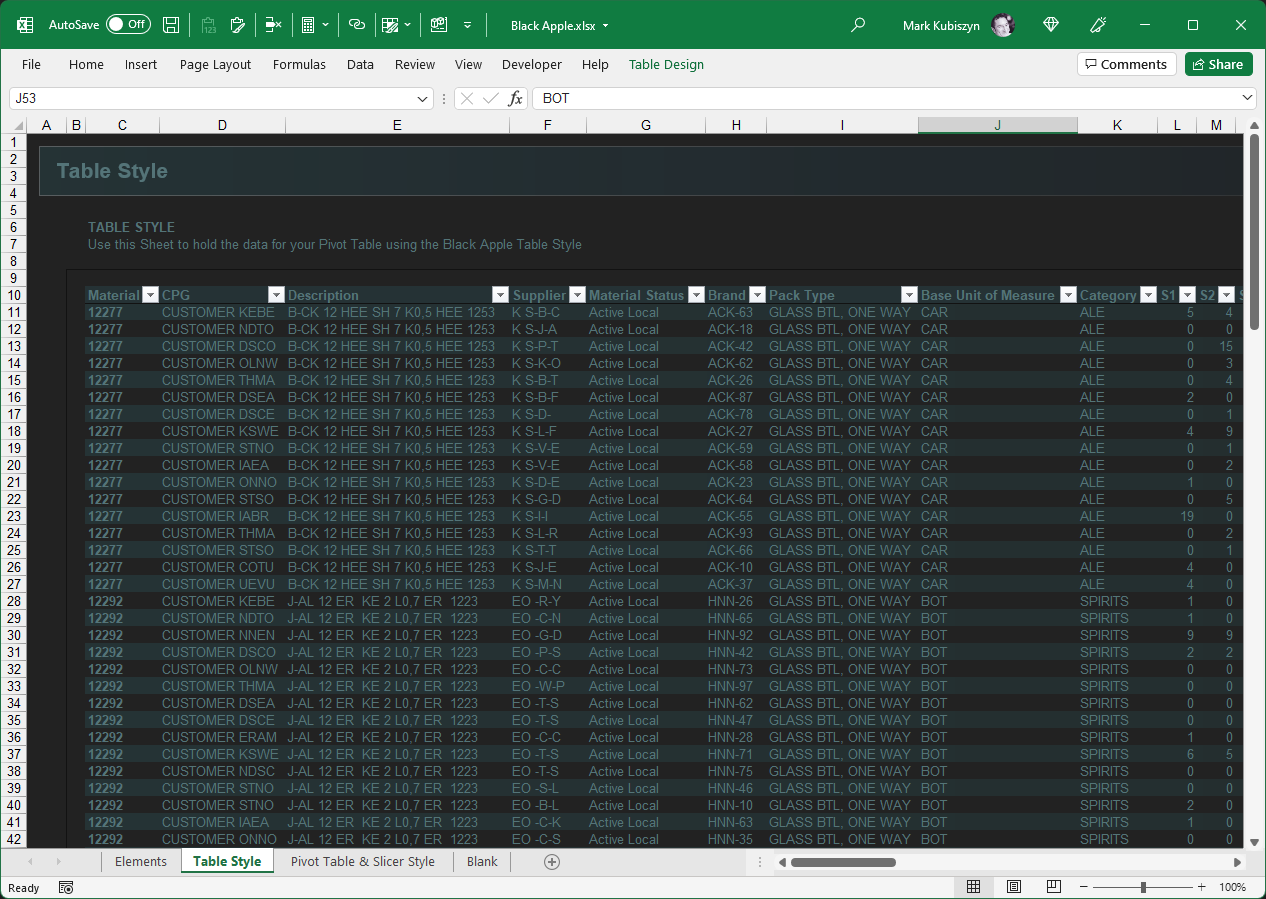
Installation
Unzip the Black-Apple.zip File and open one of the Black Apple Files (there are 4 Files in total; 2 Files being Blank and ready-to-use for new Projects). The .XLSM is Macro-enabled as it uses a modified T.O.C. (Table of Contents) Sheet built using my Treelist Software
Check out both Files. To start a new Project you can either use a copy of one of the Files that include the Pivot Table and Table data or one of the ready-to-use Blank Files - they still have the embedded Pivot Table, Slicer and Table Styles but are minified so you can quickly begin new Projects without having to mess around deleting my data
Usage
How to use Black Apple
Starting a New Project
You can start a new Project by modifying either the 'Black Apple.xlsx' File or the 'Black Apple.xlsm' (Macro-enabled) File or by using one of the uready-to-use Blank Files ie. 'Black Apple (Blank).xlsx. I would suggest using one of the Blank Files and then using the other Files to copy Elements that you may need
Adding a Table
Open the 'Black Apple (Blank).xlsx' File. To add a Table enter some data onto any Sheet - for this example I will use the Sheet named 'Table'. Select all of your data and then on the Ribbon select Insert->Table and leave the Tickbox include Headers ticked. After this Excel will insert your Table and give it a default Style like this:
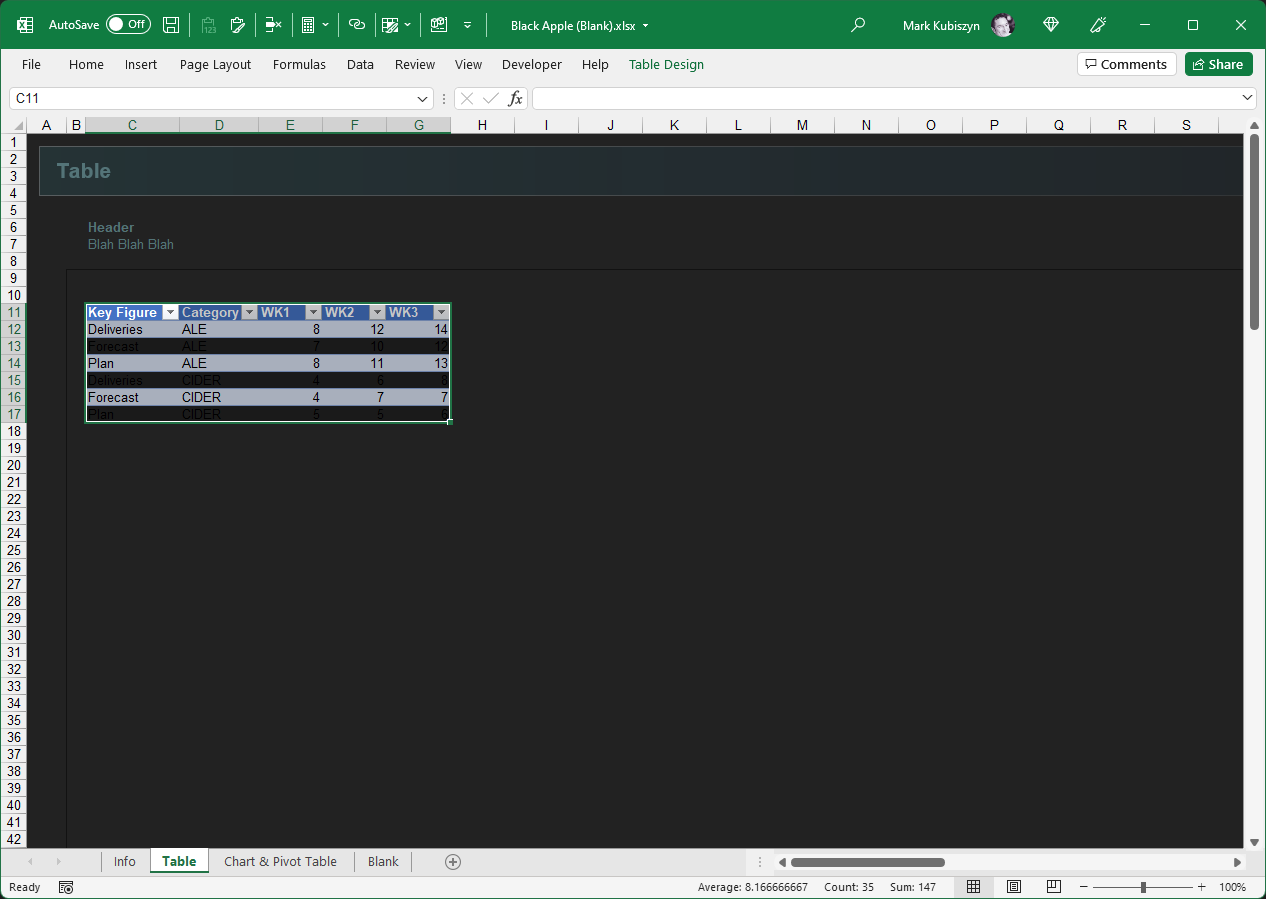
Now click on the Table Design Tab on the Ribbon and on the Select Styles Group, select the Black Apple Table Style for your Table. It should now look like this:
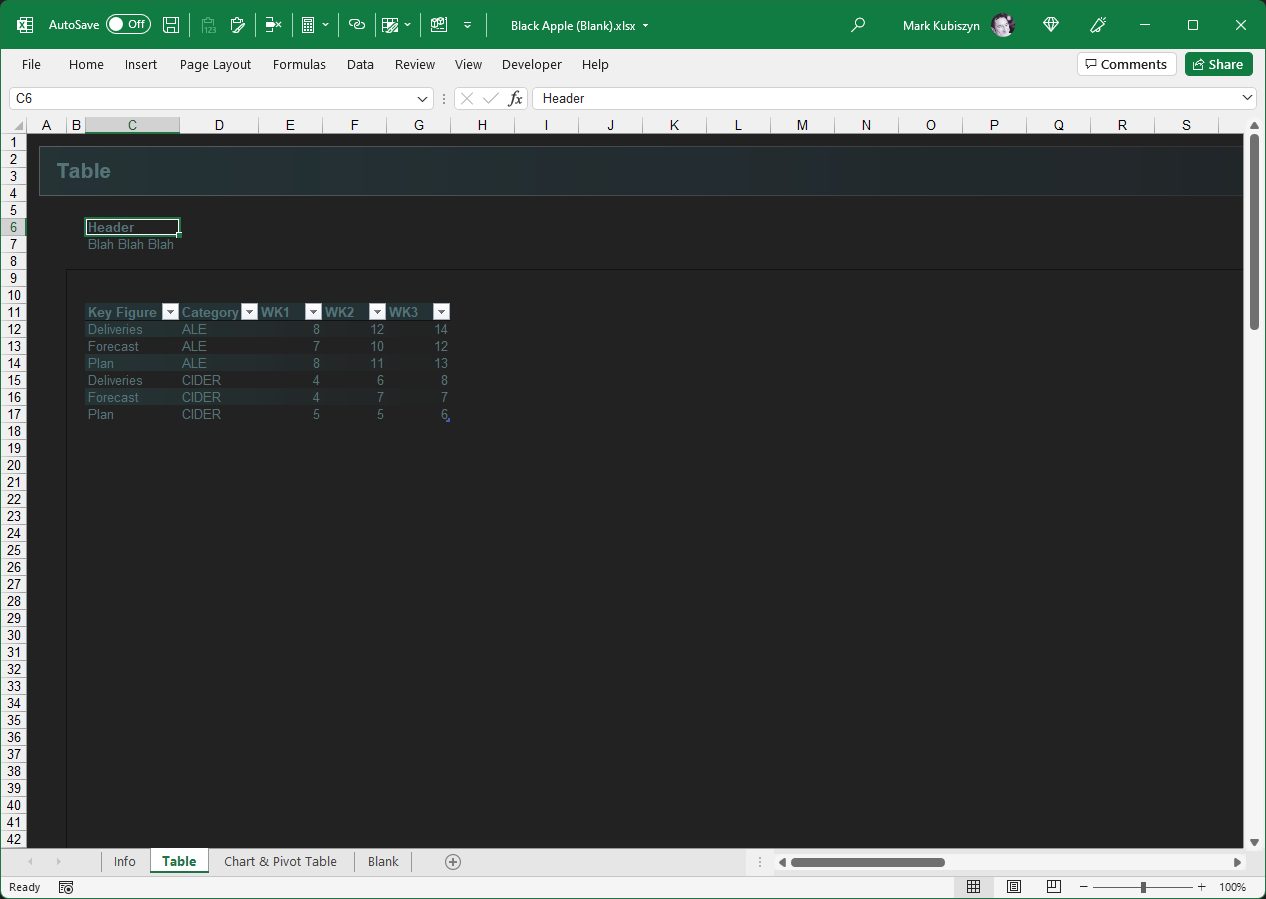
I have modified a Style to allow for most circumastances. On the Table Style Options Group on the Ribbon, you can have Banded Rows or Columns for which I have used a graduated fade. You can turn on the First and Last Column for which I have set the Font to Bold and you can turn on the Total Row for which I have styled in a different Cell Fill Colour and Font. Give your Table a Name that reflects the type of data you are storing or leave it as the default. For this example, I will leave mine as Table1
Adding a Pivot Table
Open the 'Black Apple (Blank).xlsx' File. To add a Pivot Table enter some data onto any Sheet and use it as the Pivot Table source - for this example I will use the Table I have already added called Table1 and I will add the Pivot Table to the Sheet named 'Chart & Pivot Table'. Here is what it looks like after initially linking to the Table Souce, adding the Key Figure and Category to the Rows of the Pivot Table, adding the WK1, WK2 and WK3 to the Values of the Pivot Table, changing the Table Layout to Tabular and turning off Sub-totals and Totals (you can see some Chart data has been picked up by the formula on the right-hand side of the Sheet - ignore this for now):
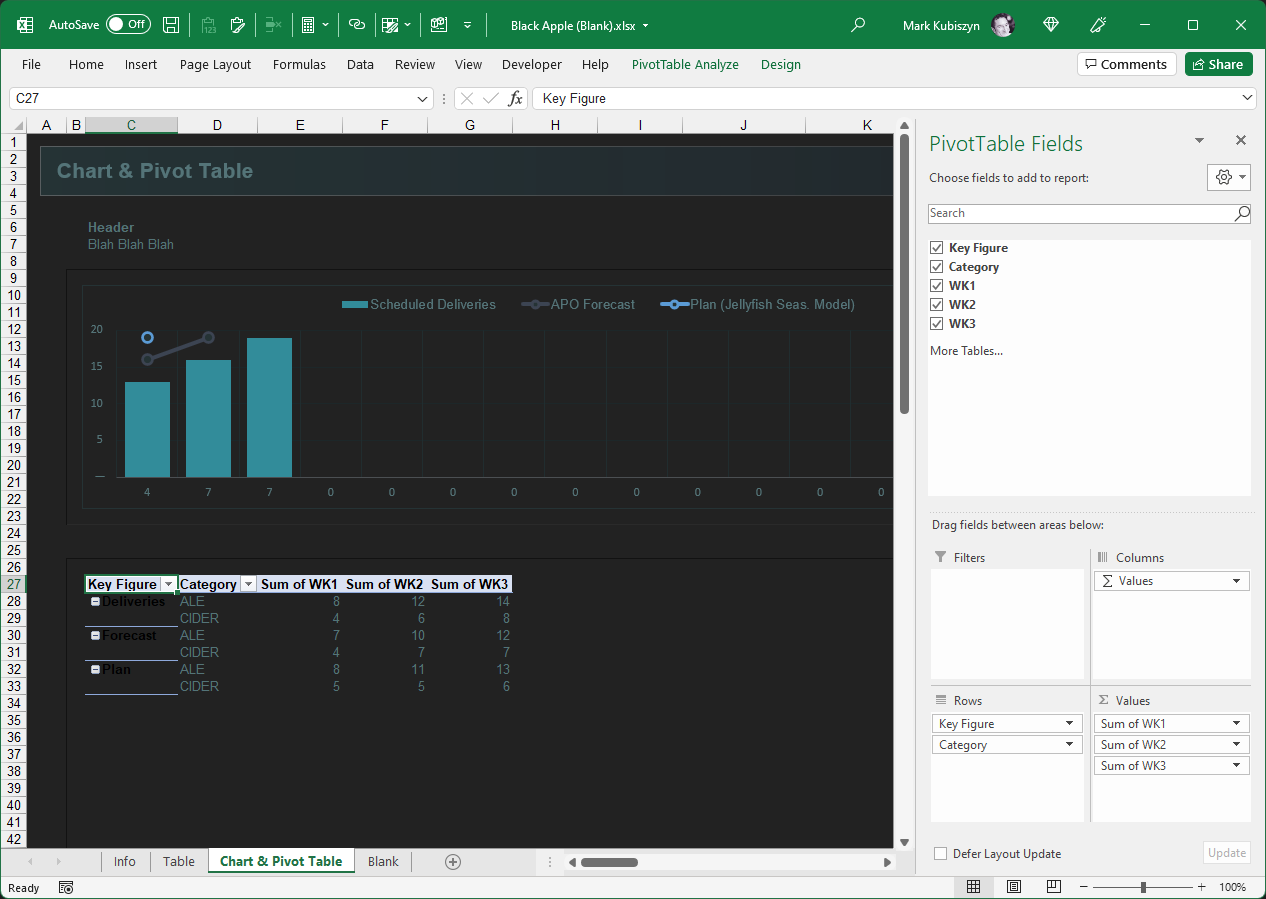
Okay, now on the Pivot Table Styles Group of the Desing Tab on the Ribbon select the Black Apple Pivot Table Style. The Pivot Table will look very different. On the Pivot Table Style Options, you can turn on the Banded Rows and Columns (I will turn on the Banded Columns) for the Pivot Table which again are graduated fades. Now your Pivot Table should look something like this:
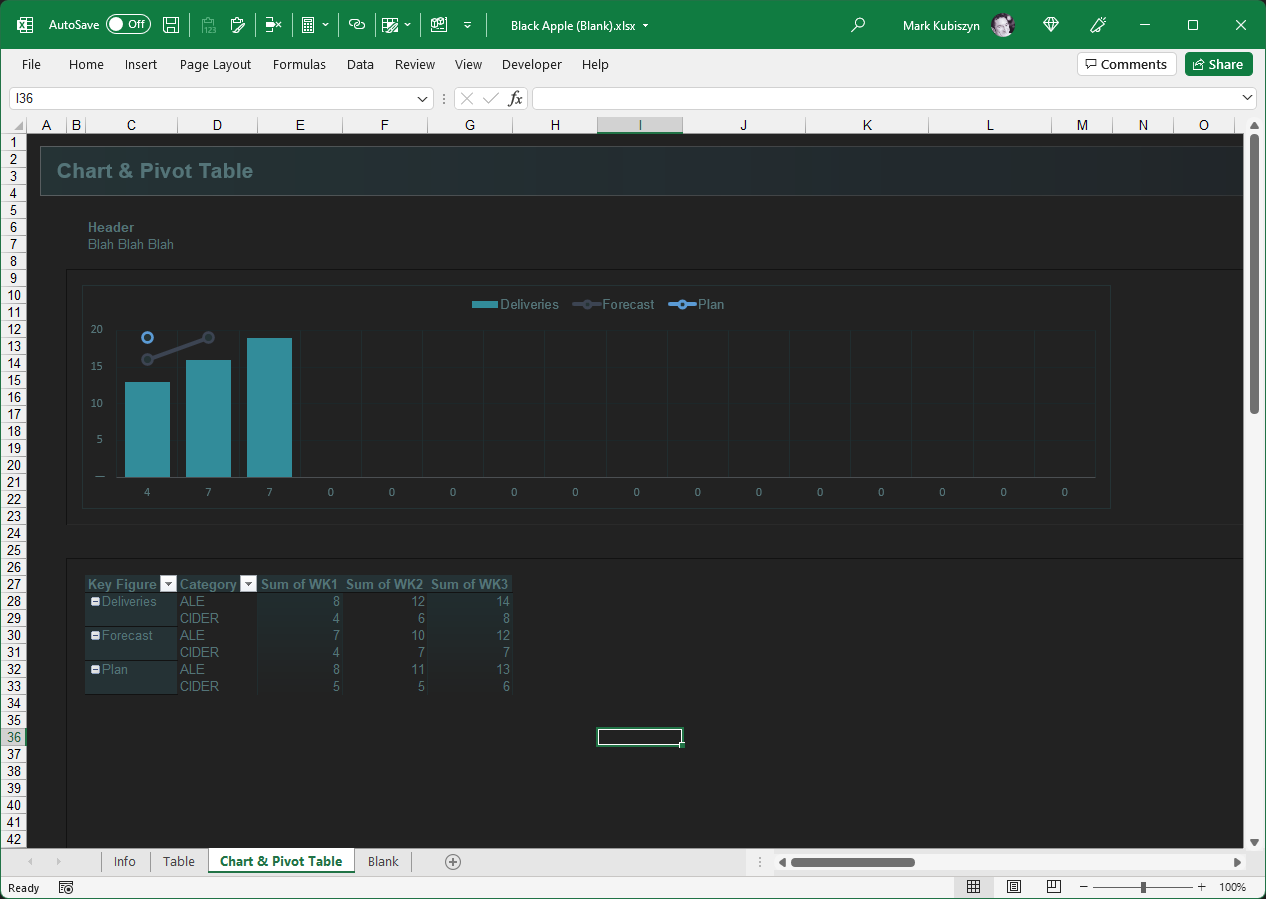
Adding a Pivot Table Slicer
I will add in a Pivot Table Slicer for the Category. Click in any Cell within the Pivot Table and on the Filters Group of the Insert Tab on the Ribbon, select Slicer. Pick your Slcier - I chose Category. Excel will give the Slicer a default Style and it will look something like this (not that attractive..!):
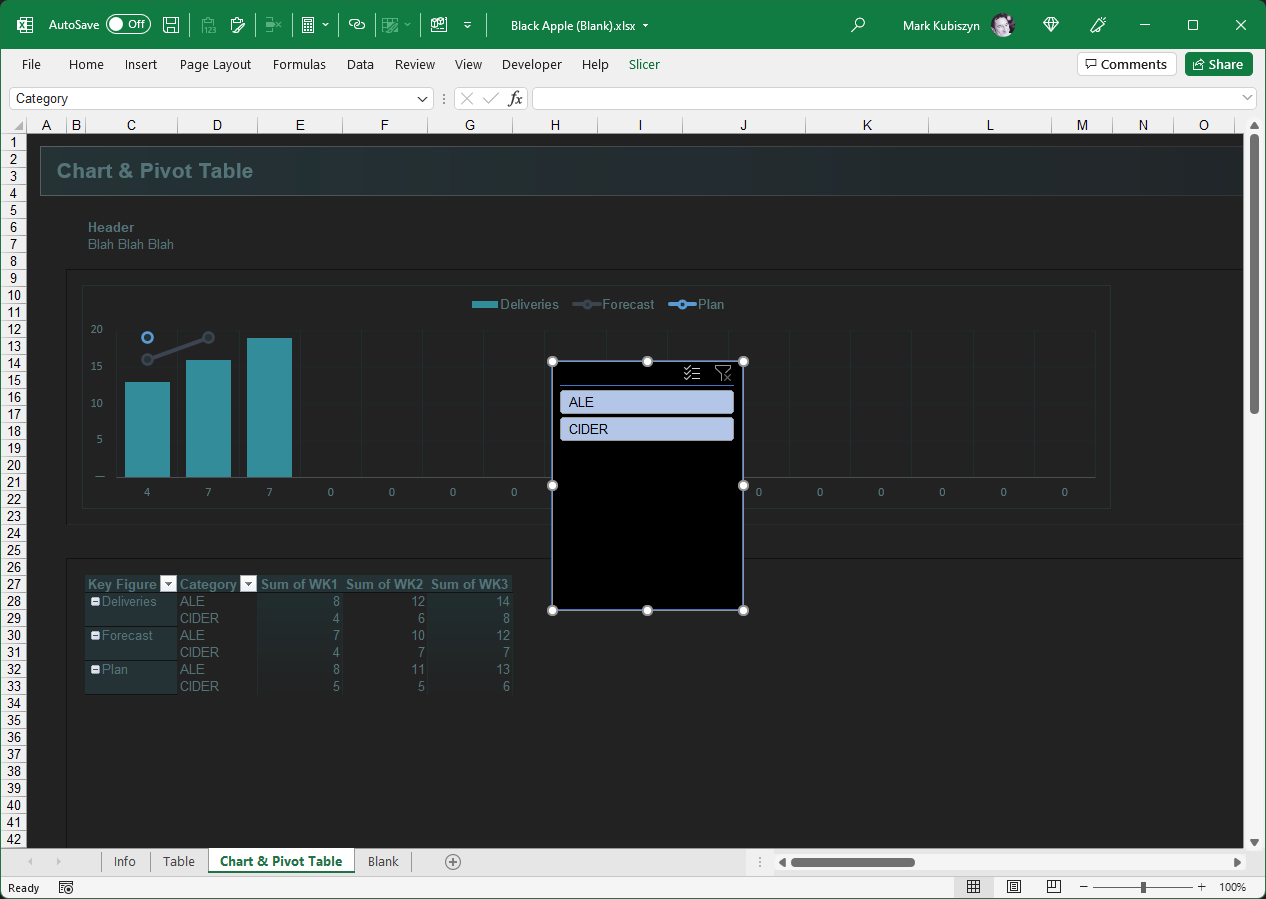
On the Slicer Styles Group of the SLicer Tab on the Ribbon, select the Black Apple Slicer Style. Resize and move the Slicer to where you want it. I moved mine next to the Chart and made the Chart width a little smaller to accomodate it for the Screen Shot. It now looks like this (much better):
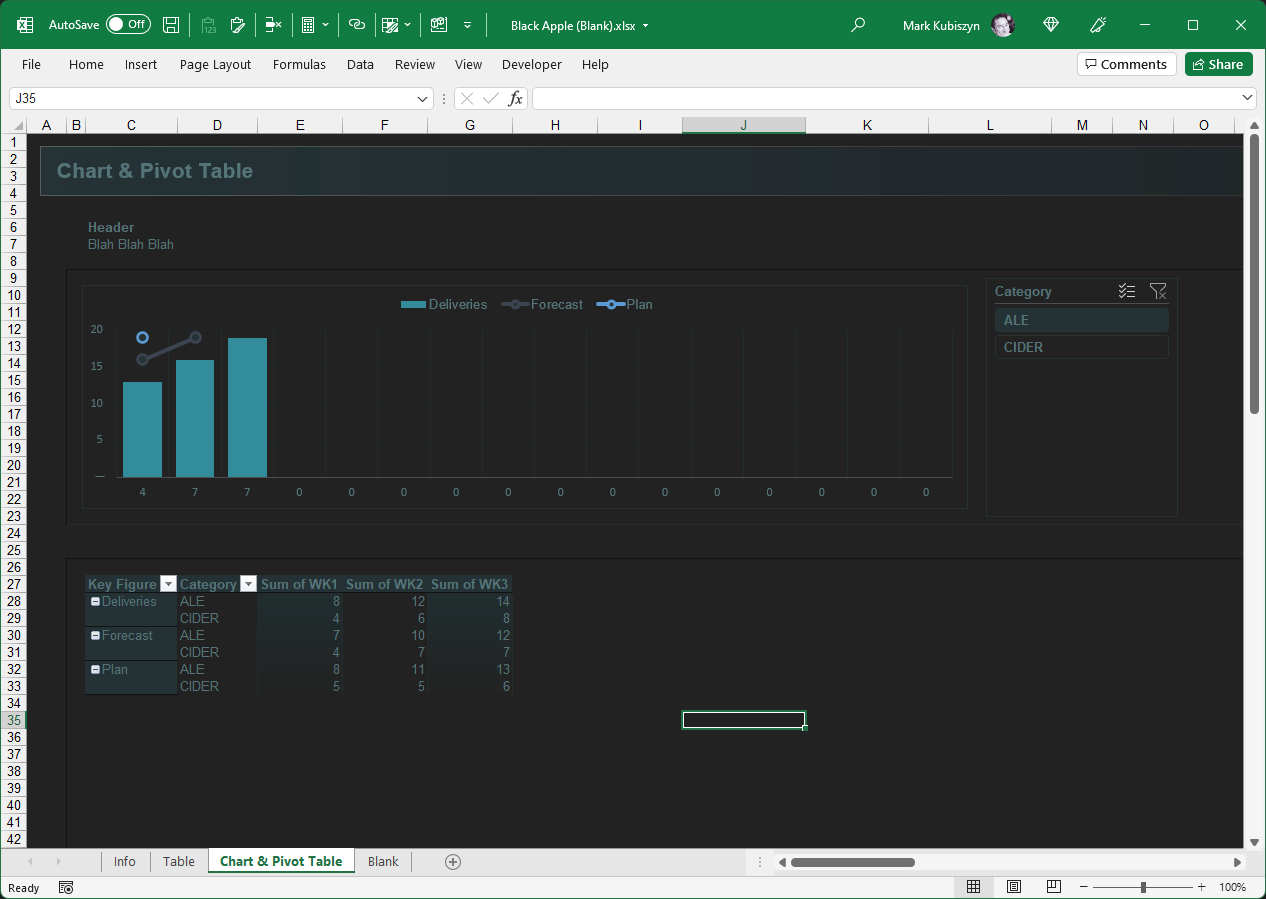
Adding Chart Series based upon the Pivot Table
I very rarely use a Pivot Chart, preferring to create my own Charts for various reasons, including more control and the loss of series styling when using Pivot Table Charts linked to Pivot Tables. There are some formula on the right-hand side of the 'Chart & Pivot Table' Sheet that SUM the range where I have added the Pivot Table. These are linked to the Chart and you can change them to suit your needs. For this example I will modify the formula so that the first 3 Columns of formula are picking up my data and then I will simply drag this formula across. In Cell AZ10 I double-clicked it and then dragged the highlighted areas to start at the top of my Pivot Table data. I then dragged the modified formula across. I overtyped the 'SUM of WK1' Column Labels with just 'WK1 ' and centered the 3 Columns of weekly data. The final result is shown here with the Category Sliced to ALE (you can hide/show the tiny expandable/collapsible Row Buttons on the Pivot Table as you wish):
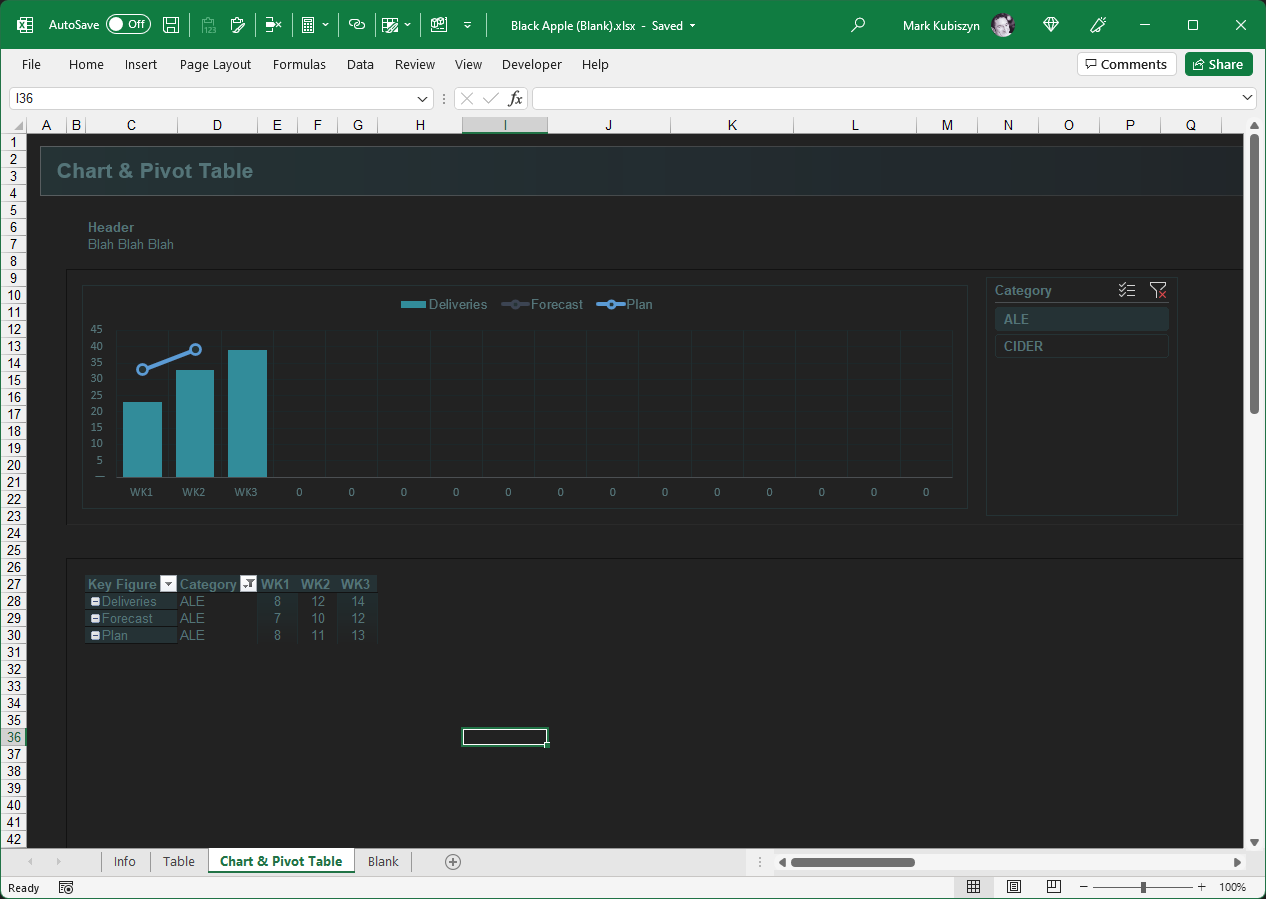
The Elements Sheet
Black Apple comes with some basic elements for you to use in your Projects. They all use the Normal Cell Style which has been modified and as such should only be used in the Balck Apple Files. THe Elemnets Sheets are available on both the .XLSX File and the .XLSM (Macro-enabled) File. There are various examples of styling on the Elements Sheet, including:
[1] 3D Borders, select a Border and Copy & Paste anywhere in your new Project File
[2] Buttons, Copy & Paste these Buttons anywhere in your new Project File, edit the Text and then use a Hyperlink or assign a Macro
[3] Colours, use the Fill or Font Colours to style your new Project (keep to a minimum for an aeshtetic look and feel)
[4] Grids, use various custom number formats to change how you layout and style your values/numbers
[5] Symbols, use simple symbols as opposed to keywords for your Headers ie. the Sigma symbol 'Σ' can be used instead of the words SUM or Total (these can be used in Tables and Pivot Tables as well)
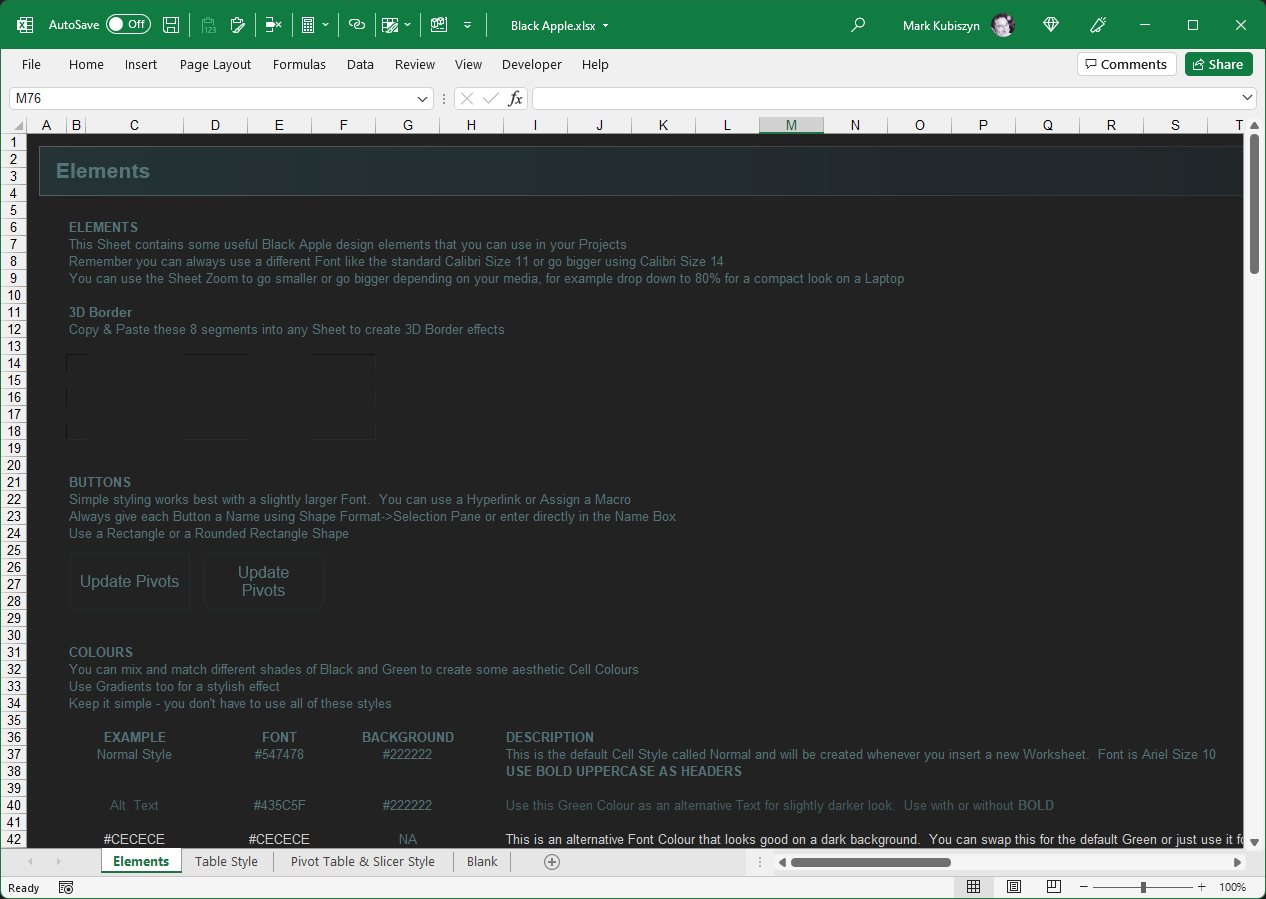
The Macro-enabled T.O.C. (Table of Contents) Sheet
One of my favourite Info or T.O.C. (Table of Contents) designs is my node toggle or Treelist view that you can use to collapse and expand Row Sections of a Sheet. This uses my Treelist Software. I have included this in the 'Black Apple.xlsm' Macro-enabled File. Open the File and click on the 'Info' Sheet. You will see a list of Contents together with a set of toggle nodes that you can click to expand and collapse the Rows. This is the Info Sheet, with all, but the first Section collapsed:
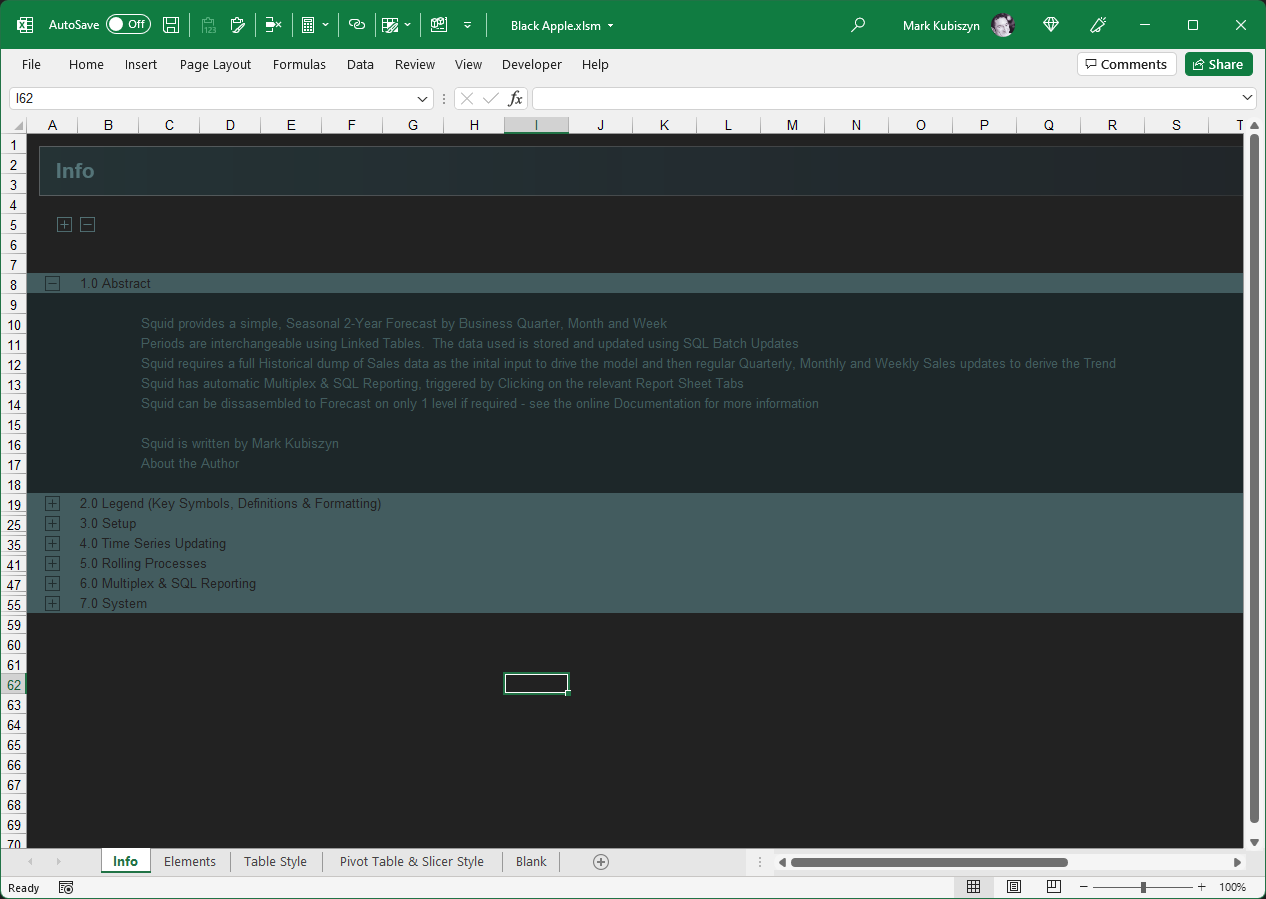
You can use the two nodes at the top to full expand or collapse the entire Sections - the '+' node expands and the '-' node collapses. You can add insert or remove Rows as you normally would as long as these are within the node Sections. To delete an entire Section, click on the '+' node and move it right, click on the '-' node and delete it. Click on the '+' node and delete it. Highlight the entire Section from the Header Row down to the last Row in the Section and delete those Rows. Please note: without my Treelist Software you are unable to insert new Sections!
Screen Shots
The Black Apple Table Style

The Black Apple Pivot Table Style

The Black Apple Slicer Style

The Demo Chart & Pivot Table Sheet

The Demo Table Sheet

An example of configuring Black Apple · The final Chart & Pivot Table Sheet after adding a new Table, linking it to the Pivot Table in the Blank .XLSX File and adjusting the formula to SUM the Pivot Table data

The Info or T.O.C. (Table of Contents) Sheet (available in the Macro-enabled .XLSM File)

FAQ
* There are no frequently asked questions about Black Apple
Videos
This is a video of the Black Apple Files. Music Game Over (Original Mix) by Fraw Get it Here · view this Black Apple video on YouTube
Support
Support is 100% optional and I provide it for your convenience, so please be patient, polite and respectful
Support for my Software
- Responding to questions or problems regarding the Software and its features
- Fixing valid (replicated) bugs and reported issues for the VERSION I HAVE WRITTEN
Software support does not include
- Customization and installation services
- Support for third party software or ANY kind of development whatsoever
Before seeking support
- Make sure your question is a valid Software Issue and not a customization request
- Make sure you have read through the FAQ's, online documentation and any related video guides before asking support on how to accomplish a task
- Ensure that you access to the VBOM is allowed and that Macros can run in Excel
- Make sure to provide 'proof of purchase' and state the name / version of the Software that you are having issues with when requesting support by Email or via Facebook
How to get Support
Contact Mark Kubiszyn on the Email address provided when you purchased the Software, including the Order Number
Remember to be patient, if there has been an issue with your download, Mark will always respond within 48 hours and will Email you the File directly if neccessary. For other issues the response time may be considerably longer and I may choose to respond to specific questions only (as is my right), depending on what has been asked
Future Builds
* No ideas as yet!
Bug Fixes
* There are currently no bugs identified for Black Apple
Changelog
Read more information on the status of each release below. The latest Version including a description of any changes is shown first
14.12.2021
General Release of Black Apple